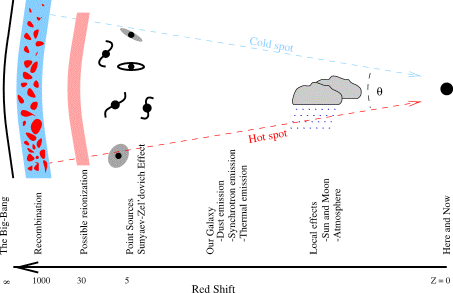Introduction to the Cosmic Microwave Background

The cosmic microwave background (CMB) is thought to be the cooled remnant of the light from the Big Bang. Although predicted as early as 1948 it was not until 1965 that the CMB radiation was first detected (and then only by accident).
Matter in the early Universe - up until about 400,000 years after the Big Bang - could not exist as neutral atoms; the temperature would have been too high. This means that there would be many free charged particles; electrons in particular. Since photons (light) interact with charged particles, the early Universe must have been opaque. With the passage of time, as the Universe expanded so it cooled. At a temperature of around 3000 Kelvin (around 2726°C) neutral atoms would have formed so that the photons of light would no longer interact with matter. The photons would then head off, unhindered by scattering until we collect them with our telescopes. The point when light stopped interacting with matter is known as the epoch of recombination.
The CMB is the oldest signal detected by any telescope, being almost as old as the universe itself. This means that it comes from the greatest distance. Radiation from astronomical sources is red-shifted which means that the wavelength of the radiation is stretched. With increasing distance the red-shift increases. The CMB comes from such a distance that the red-shift is a factor of about 1000 times. This is also the factor by which distance scales in the universe have stretched since the recombination epoch. What started as light (of a similar colour to the cooler giant stars, which have about the same temperature of around 3000 K) has been stretched in wavelength by 1000 times, to become microwave radiation. The CMB spectrum is now that of a 2.7 K blackbody.
The universe, at the time of recombination, is thought to have had a very different structure to the universe in which we live today. It was too early for galaxies to have formed. Matter was spread out very evenly. However, there should have been some structure. Slight increases in matter density, that would eventually lead to the formation of galaxies or clusters of galaxies, should have been present, and should have left an imprint on the CMB. They can do this through mechanisms such as Doppler shifts or the gravitational red-shift acting on photons emerging from a region of increased mass. The levels of irregularity in the CMB predicted by various cosmologies range from a few parts per 10,000 to a few parts per 100,000. The theories that predict the strongest structures were ruled out for several years ago by CMB experiments. Only in the last few years have CMB telescopes been constructed with sufficient sensitivity to detect irregularities, and we are now mapping them.
From the theory we expect the level of structure to depend upon angular scale. That is, CMB anisotropies should have a particular spatial frequency spectrum. For instance, a scale of roughly 1° corresponds to the horizon scale (the maximum range at which one region could have affected another, due to the finite speed of light) at recombination. Around this scale we expect to observe a peak in anisotropies.


